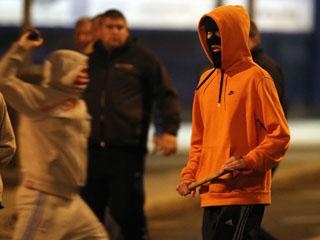Equality of misery? Poverty and political violence in Northern Ireland

When the East Belfast riots erupted in late June, few who work in and with working class communities were surprised. We had known for some time that the UVF was recruiting young people and threatening to organise mass riots if its command structures – sorry, that should of course read ‘community workers’ – weren’t guaranteed ongoing funding after EU Peace money runs out in 2012.
But in order to produce mass riots, paramilitaries have to be able to recruit and, again, there was little surprise at the relative ease with which the UVF could do this. In 2009, I wrote a ‘Viewpoint’ about child poverty in Northern Ireland for the Joseph Rowntree Foundation (unless otherwise stated, any statistics below are taken from this). Based on research carried out by myself and others, the document warned that the long-term cost of child poverty in the North could be a lot higher than in the South or in Britain and failure to tackle it could see another generation of young people look to paramilitarism as a response to social injustice.
Child poverty in the North is very concentrated, with more than half of all children living in households dependent on benefits residing in 16% of wards and more than three quarters living in 37% of wards. The children living in these areas grow up in communities that experience the same toxic cocktail of poverty, deprivation, poor health, including high levels of mental ill-health, low educational attainment and discrimination that people living in the most disadvantaged parts of the South or Scotland, England and Wales face. In addition, however, they grow up in communities that are in deep social distress in the aftermath of the conflict.
Worse still, violence continues to be a part of life in those communities. The Childhood in Transition study reported young people speaking of powerful individuals, who claimed links to paramilitary groups, recruiting youngsters to take up their agenda. Children and young people were influenced in the local community by glorification of the past and encouraged to take part in riots and sectarian actions. While newspapers, police and politicians focus on the ‘anti-social’ and violent behaviours of children and young people, the wider social and cultural context is lost. Young people in places like the Bogside, as well as East Belfast, grow up surrounded by murals that glorify paramilitarism and honour past riots. Their communities have frequent commemoration ceremonies where the message is clear: the people honoured in this community are those who fought for ‘our’ side.
For some young people, especially those failed by the education system and the chronic lack of jobs in much of Northern Ireland, and so denied a more positive role in society, rioting, including sectarian rioting, is a pro-social activity that demonstrates they are part of the community, like those depicted in the murals. There is a lot of hopelessness, which is understandable since a third of 16-24 year olds are not in education, training or employment. And there are few people in their areas with jobs, since most professionals, including community workers, who get a decent job move out of these districts.
One of the most noticeable changes in relation to poverty in Northern Ireland over the last 20 years is the way in which Protestant working class areas are climbing steadily up the deprivation figures. So, while Catholic areas overwhelmingly dominated the 10% most deprived areas 20 years ago, today about four out of ten of the most deprived areas are Protestant. There are many reasons why this is the case: the engineering and other manufacturing jobs that used to provide relatively well-paid, secure employment for those areas have gone. Furthermore, educational disadvantage hits the Protestant section of the working class, especially boys, worst – though all children in the North are poorly served by a selective education system.
So, Protestant young people are less likely to get a minimum-wage job in the many call centres that have come to Northern Ireland than their better-educated Catholic counterparts. Agency work is often the only option, doing jobs that earned £12 an hour ten years ago but now only attract the minimum wage (£5.93 for employees over 21) and have no security. Even before the recession, median wage levels in the North generally were just 85% of those in Britain and over £15 a week less than the next lowest paid region of the UK, the North East of England.
All of this leads to an important point: Protestant working class areas have been moving up the deprivation ‘league’ year on year, but this is not because Catholic areas have seen a reduction in poverty. Rather, this convergence is the result of a pushing down of wages for all workers. Northern Ireland is marketed across the world as a low-wage economy. As a result, more than half of all households in the North are dependent either on benefits or on working tax credits, while about a quarter of households are doing very well indeed and can still afford foreign holidays and second homes.
There’s worse to come. The Stormont budget is to see £4 billion in cuts over the coming period. At least 4,000 jobs are set to go in the public sector, with massive cuts in services already under way. This could see the two working class communities blaming each other for their growing poverty. Certainly, over the summer months, there is potential for a return to large-scale sectarian violence. But there is potential also for a united fightback. This autumn should see massive strikes by workers across the North, with the potential to break the chains of sectarianism in the course of common struggle.
